#Vamana - Parashurama
Text
10 vintage paintings of 10 Avatars Of Hindu God Vishnu:
Matsya, Kurma, Varaha, Narasimha, Vamana, Parashurama, Rama, Krishna or Balarama, Buddha or Krishna, and Kalki.
#IndianPaintings of#HinduGod#Vishnu#tenAvatars#Matsya#Kurma#Varaha#Narasimha#Vamana#Parashurama#Rama#Krishna or#Balarama#Buddha or#Krishna#and#Kalki.#vishnu#hindu#india#god#vintagepainting#painting#vintage#art#vintageart#vintagestyle#artist#midcenturyart#artwork
2 notes
·
View notes
Text
Vishnu Dashavatar (10 Incarnations)
#dashavatar#vishnu avatars#vishnu#lord vishnu#matsya#kurma#vamana#lord narasimha#parashurama#lord rama#lord krishna#lord buddha#lord kalki#vishnu incarnation
0 notes
Text
When the world is getting too corrupt:

I mean, there are 10 avatars...wait a minute...
Wildmutt - Narasimha (wild animals)
Four Arms - Krishna (strong wrestlers)
Gray Matter - Vamana (smol)
XLR8 - Varaha (boars known for charging)
Upgrade - Parashurama (upgrades tech/students)
Diamondhead - Kurma (land/earth aesthetic)
Ripjaws - Matsya (fish)
Stinkfly - Rama (snipers)
Ghostfreak - Buddha (OP and beyond mortals)
Heatblast - Kalki (Everything started/ended with them)
#hindu memes#hindugods#hindu mythology#dashavatar#i just realized that since there are ten#vishnu is the original ben 10#hinduism#hindudeity#vishnu#hinduism headcanon#hinduism headcanons#ben 10
139 notes
·
View notes
Text

“The world rests as the lotus in the palm of my hand, the cosmos revolves around my finger like a discus. I blow the music of life through my conch and wield my mace to protect all creatures.” – Krishna Upanishad
The Multiverse as Vishnu's Dream
Talon Abraxas
While Brahma creates the Universe, Vishnu is the source of all Creation. And he also sustains and protects the Universe making his role a lot more complex than that of Brahma’s.
Vishnu is the All-Pervading One, derived from “vis’ in Sanskrit which means both ‘to spread’ and ‘to be present everywhere’.
Even when there was Nothing, there was Vishnu, present as a nameless, formless, dormant energy. In this un-manifested (nirguna) state, even Vishnu was not aware of his own being. He just was. But just because he was not perceived, does not mean he did not exist.
In this Nothingness, when the first ripple of awareness stirred , spontaneously and of its own will, the formless energy became Vishnu, the Supreme Being, Parabrahman.
As Parabrahma, Vishnu lies in a dream like state on the serpent Adisesha Ananta who is Time, without beginning or end. Ananta floats for all eternity on the waters of the Ksheer Sagar ( the ocean of Cosmic Consciousness).
When Brahma begins the process of Creation, it is Vishnu who expands into everything and becomes part of everything. Now he is Brahman, the Cosmic Consciousness.
As if he is seeing a dream, Vishnu watches Brahma create the Universe. By the act of watching his dream, Vishnu sustains the Universe. When Vishnu wakes from his dream one cycle of Creation ends.
Vishnu who dreams up the Universe must also now protect it. To maintain the order of Creation, Vishnu becomes The Protector. He takes the form of Ishwara or God.
This form of Vishnu looks very different from the one reclining on Ananta. He is standing,radiant as the sun and has four arms. In his hands he holds the Conch, The Discus, The Lotus and The Mace.
From the Nirguna Brahman( formless energy) Vishnu thus becomes Saguna Brahman, a God with forms and attributes. Vishnu is now the Supreme Lord, Parameshwar.
At times, when world descends into total chaos, Lord Vishnu comes to its rescue in the form of an Avatar, or incarnation.
The ten incarnations of Vishnu in the physical world are:
1.Matsya (fish)
2.Kurma (turtle)
3.Varaha (boar)
4.Narasimha (man-lion)
5.Vamana (dwarf)
6.Parashurama (warrior-priest)
7.Rama ( man who was like God)
8.Krishna (God who was born as man)
9.Buddha (the enlightened one)
10.Kalki (horseman, who has not yet appeared)
References to Vishnu are found even in the Rig Veda, the oldest of the scared texts.
38 notes
·
View notes
Text
ASIAN MYTHOLOGY
-Hindu Mythology-
Here is a piece of the larger framework of Asian mythology located in India
हिंदूपौराणिक कथा will refer to the mythological framework of people in INDIA near the INDUS VALLEY that has been upheld for nearly FOUR MILLENNIA. Creation is accredited to Brahma; the creator of everything. He will, nonetheless, emerge from a GOLDEN EGG. Its pantheon, including him, will center around the TRINITY OF GODS that will include BRAHMA, VISHNU, AND SHIVA. There are other deities that exclude THE TRINITY that will represent GOD in another form known as an AVATAR. From this, the mythology made in their image was given to account for the CUSTOMS of the people of India.
THE GODS OF THE TRINITY
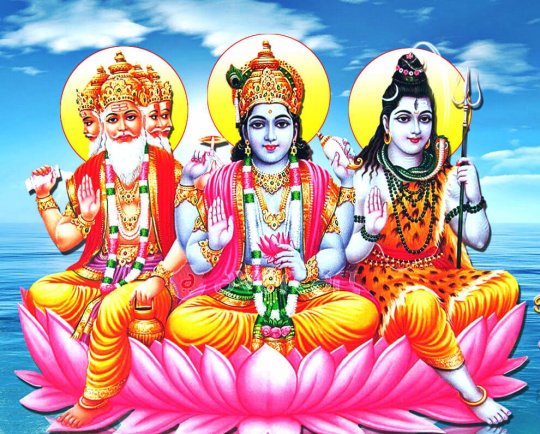
■LORD BRAHMA is the creator
■LORD VISHNU is the God tasked with the preservation of creation
■LORD SHIVA is the destroyer
------------------------------------------
[2]
THE AVATAR OF BRAHMA
1st AVATAR
■Valmiki -> वाल्मिकि
2nd AVATAR
■Kashyapa -> कश्यप
3rd AVATAR
■Shukra -> शुक्र
4th AVATAR
■Bachesa -> बचेसा
5th AVATAR
■Vyasa -> व्यासः
6th AVATAR
■Khata -> खटा
7th AVATAR
■Kalidasa -> कालिदासः
THE AVATAR OF VISHNU ARE CALLED -> Dasavatara
1st AVATAR
■Matsya -> मत्स्य
Vishnu took the form of Matsya to rescue the first man, as well as any other creature of the earth, from a global disaster. He accomplished this by having forewarned mankind about the coming flood, and he ordered him to gather up all of the grain and to preserve any creature in a great boat.
2nd AVATAR
■Kurma -> कूर्म
Vishnu took the form of Kurma to churn the ocean in order to reach any treasure dissolved in the ocean of milk. He placed it on his back for support, which gave him the leverage needed to stir that great volume.
3rd AVATAR
■Varaha -> वराह
Varaha raised the earth from the bottom of the sea after Hiranyaksha dragged it there; it only took a millennia to do that, but he did it.
4th AVATAR
■Narasimha -> नरसिंह
Hiranyakashipiu obtained a special blessing from Brahma that he could not be killed or harmed by any means. That made him arrogance. As a result, he began causing trouble both in heaven and on earth. Prahlada, however, was devoted to Vishnu. Angered by that, he challenged his son to fight him. Narasimha emerged. And then, he slayed Hiranyakashipiu.
5th AVATAR
■Vamana -> मातरः
6th AVATAR
■Parashurama -> परशुरामः
7th AVATAR
■Rama -> रामः
8th AVATAR
■Krishna -> कृष्ण
9th AVATAR
■Buddha -> बुद्धः
10th AVATAR
■Kalki -> कल्कि
THE AVATAR OF SHIVA
1st AVATAR
■Tatpurusha -> तत्पुरुषः
2nd AVATAR
■Namadeva -> नामदेव
3rd AVATAR
■Aghoresh -> अघोरेश
4th AVATAR
■Sadhojat -> वनस्पति
5th AVATAR
■Ishan -> ईशान
------------------------------------------
LINEAGE OF SHIVA
Lord Shiva with Devi Sati

Lord Shiva and Devi Parvati
■Kartikeya
His first son
■Ganesha
His second son
■Ashoka
His daughter
2 notes
·
View notes
Text
HOW MANY VISHNU AVATARS ARE THERE?

Reading time- 5 mins
In Hindu mythology, Lord Vishnu, the preserver, and sustainer of the universe, is believed to have taken various avatars (incarnations) throughout history. These avatars serve a divine purpose, restoring balance and righteousness in the world. Let's explore the fascinating stories behind the ten most significant avatars of Lord Vishnu.
1. Matsya Avatar (The Fish Incarnation):
As Matsya, Lord Vishnu appeared as a giant fish to save humanity from a catastrophic flood. He guided the sage Manu's boat to safety and preserved life during the deluge, symbolizing protection and preservation.
2. Kurma Avatar (The Tortoise Incarnation):
In this avatar, Vishnu assumed the form of a giant tortoise to support the mythical Mount Mandara during the churning of the cosmic ocean. The Kurma avatar represents stability and patience.
3. Varaha Avatar (The Boar Incarnation):
As a boar, Vishnu rescued the earth goddess, Bhudevi, by lifting her out of the primordial ocean. Symbolizing strength and protection, the Varaha avatar restored order and ensured the continuity of life on Earth.
4. Narasimha Avatar (The Lion-Man Incarnation):
Lord Vishnu took the form of Narasimha, a half-lion, half-man being, to protect his devotee Prahlada from the demon king Hiranyakashyap. Narasimha is considered a symbol of divine wrath against evil forces.
5. Vamana Avatar (The Dwarf Incarnation):
In the Vamana avatar, Lord Vishnu appeared as a dwarf Brahmin to restore balance by curbing the arrogance of the demon king Bali. Through humility and righteousness, Vamana regained control over the three worlds.
6. Parashurama Avatar (The Axe-Wielding Incarnation):
Parashurama, an embodiment of Lord Vishnu, manifested as a warrior sage wielding a mighty axe. He eradicated the corrupt and tyrannical Kshatriya rulers to restore justice and righteousness.
7. Rama Avatar (The Ideal King Incarnation):
The epic tale of Ramayana narrates the life of Lord Rama, an exemplary ruler, and embodiment of righteousness. As Rama, Lord Vishnu defeated the demon king Ravana and showcased the ideals of dharma (righteousness) and devotion.
8. Krishna Avatar (The Divine Flute Player Incarnation):
The charismatic Krishna, a beloved deity in Hindu mythology, embodied love, compassion, and divine wisdom. As the central character of the Mahabharata, Krishna guided Arjuna on the path of righteousness in the Bhagavad Gita.
9. Balarama Avatar (The Elder Brother Incarnation):
Balarama, the elder brother of Krishna, represents strength and loyalty. He supported Krishna in his divine mission and was revered as a symbol of agricultural prosperity and power.
10. Kalki Avatar (The Future Incarnation):
The Kalki avatar is yet to come, as Lord Vishnu's final incarnation. It is believed that Kalki will appear at the end of the Kali Yuga (the current age of darkness and moral decline), riding a white horse, to restore righteousness and initiate a new golden age.
The avatars of Lord Vishnu are not merely mythical tales but carry profound symbolism and teachings. Each avatar reflects a divine purpose, illustrating various aspects of Lord Vishnu's role as the preserver and the protector of the universe. The stories of these avatars continue to inspire millions, imparting valuable lessons about righteousness, devotion, and the triumph of good over evil.
Our brand Prabhu Shriram- India’s Best Agarbatti and Dhoop is based on the ideologies & life lessons of Lord Vishnu’s avatar Lord Rama. Our bestselling product, India’s First ever award-winning masterpiece Incense Collection, the“Shripad Ramayana Series” Divine Box is a one-of-a-kind collection of ten amazing variants illustrating Prabhu ShriRam’s ten major life episodes:
Prabhu Avataran; Guru Kripa; Dhanush Khandan; Sita Aagman; Kevat Prem; Swarn Hiran; Sugriv Sahyog; Vatika; Ram Darbar; Agni Pariksha.
The exclusive packaging of these incense sticks is curated and hand painted by artists from Mithila and represented in the world-famous “Madhubani Paintings” to create a pack as special as the product. These incense sticks invite profound prayers with their exquisite and unique fragrance. Dive into a fragrant experience infused with essential oils & fabled herbs that bring you closer to your Indian roots.
5 notes
·
View notes
Text
The One who is nor finite, neither infinite.
The One who is before time and after it, who regulates the past, the present and the future.
When there was no creation, no time, he was there. All was the manifestation of him.
When there is no darkness, no light, no air, no water, no sense, no intellect. All were emerged from him because the seed is 'Him'.
One among the three creators who embodies brahman. Residence of whole world in him as He, himself is the Supreme.
He was never born, neither he was unborn.
He was the Yahweh, the creator of all.
Called as a " Sukrittarah"--The best among the best who gives the result.
He is never 'was' , 'am' or 'will'. He is the Supreme being of 'kaal' or 'Time'.
Incarnated himself 10 times in the form of Vamana, Varaha, Rama, Krishna, Parashurama....
Put up his 'Sarang' to destroy the evils and for the uplift of righteousness.
The One who put himself forth whenever it is needed to destroy the injustice and prevention of sinful and wicked.
You are mortal because you are a part of him.
Because
He is Eternal.
I give you
The Vasudev..
" VISHNU "
○●○
Anurag Sharma
#my writing#srbachchan#writers#words#writers on tumblr#hindu culture#quotes#mahabharat#ramayana#vishnu
2 notes
·
View notes
Text
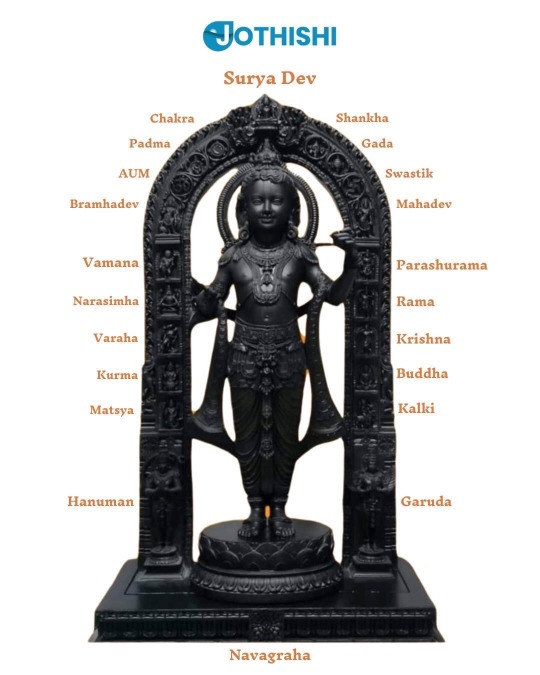
The magnificent 51-inch black stone idol shows Lord Ram as a five-year-old child. The right hand of the idol shows him giving 'aashirwaad' and designed to hold an arrow while the left hand is designed to hold a bow. 😇
✨All 10 avatars of Lord Vishnu
On both sides of the Ram Lalla idol, the incarnations of Lord Vishnu are engraved. The ten avatars namely Matsya, Kurma, Varaha, Narasimha, Vamana, Parashurama, Rama, Krishna, Buddha and Kalki are engraved on the idol.
✨Other Gods depicted on the idol
Near the right foot of the idol, Lord Hanuman has been engraved. And near the left foot of the idol, Lord Garuda (mount of Lord Vishnu) is seen.
✨Hindu religious symbols
Around the head of Ram Lalla idol, Hindu religious symbols like the Swastik and the Om symbol have been carved. A Chakra, a Gada and a Shankh are also seen engraved in the idol. 🙏
.
.
.
.
.
#ram #ramayana #lordram #ayodhya #RamMandirAyodhya #ramlala #rama #matsya #kurma #varaha #narasimha #vamana #parshurama #krishna #buddha #kalki #ayodhya #pranpratishta
1 note
·
View note
Text

Jambavan
Jambavan (sánscrito: जाम्बवान्, romanizado: Jāmbavān), también conocido como Jambavanta (sánscrito: जाम्बवन्त, romanizado: Jāmbavanta), es el rey de los osos en los textos hindúes.
Emerge de la boca de Brahma cuando la deidad creadora bosteza. Él ayuda al avatar Rama de Vishnu en su lucha contra el rey rakshasa Ravana.[3] En el Ramayana, ayuda a Hanuman a darse cuenta de su potencial, justo antes de su famoso salto a la isla de Lanka.Jambavan estuvo presente en la agitación del océano, y se supone que dio 21 vueltas a Vamana en un solo salto, cuando estaba adquiriendo los tres mundos de Mahabali.
Se considera que Jambavan, junto con Parashurama y Hanuman, es uno de los pocos que estuvo presente tanto para los avataras de Rama como para los de Krishna. Su hija Jambavati estaba casada con Krishna.
0 notes
Text

The Dashavatara: the ten primary avatars, or incarnations, of the Hindu god, Vishnu.
They are:
Matsya - the fish
Kurma - the turtle
Varaha - the boar
Narasimha - the lion
Vamana - the dwarf
Parashurama - the warrior-sage
Rama - the prince
Krishna - the black- or blue-skinned
Buddha - the awakened
Kalki - the prophesied
1 note
·
View note
Link
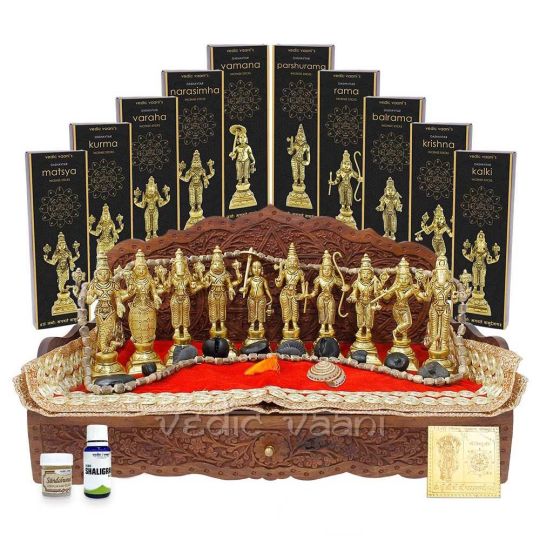


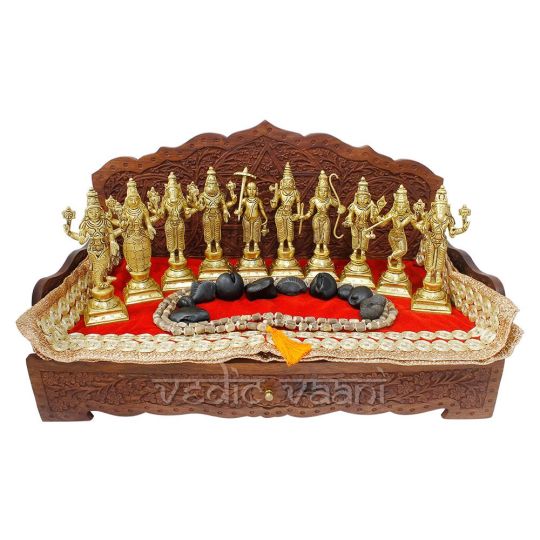

Exotic Vishnu Dashavatar Idols with Natural Shaligram Shilas Set - Dashavatara statues and Natural Small ten Shaligram stones are represented ten avatars of Lord Vishnu. Idols are made in best quality brass with antique finish and big handcrafted wooden Singhasan for installing Dashavatar Idols and Shaligram stones. When the balance between good and evil tilts in favor of evil, Vishnu appears upon the earth as one of the ten Vishnu avatars or dashavatar to restore the balance.
Dimensions:
Shaligrams: 0.75 to 1.8 inches (L) x 0.75 to 1.5 inches (W) x 0.5 to 1.25 inch (H) (2 to 4.5 x 2 to 4 x 1 to 3 cm) average size approx
Idols: 6 inches (H) x 2.75 inches (W) x 1.8 inches (depth) (15 x 7 x 4.5 cm) average size approx
Singhasan:
Outside: 11.75 inches (H ) x 20 inches (L) x 10.5 inches (W) (30 x 51 x 27 cm) approx
Inside: 8.5 inches (H) x 19 inches (L) x 9.75 inches (W) (21.5 x 48 x 25 cm) approx
Velvet gadi: 21 inches (L) x 21 inches (W) (53 x 53 cm) approx
Tulsi Mala:
No. of beads: 108+1 (6 to 9 mm approx), 48 inches (120 cm) (Circumference) approx
Total Weight of set: 10 Kgs approx
For More Visit Below Link :
https://www.vedicvaani.com/vishnu-dashavatar-idols-shaligram-shilas
Call Us On: 9820697944
Email Id: [email protected]
#dasavatar#vishnu#shaligram#brassdecor#traditionaldecor#omnamonarayanaya#kurma#matsya#varaha#narasimha#hinduism#vamana#parashurama#balram#ram#kalki#krishna#tenavatar#hindu#hindugod#brassidols#divineindia#brassdasavatar#shoponline#india#vedicvaani#vedic#vaani
1 note
·
View note
Photo

Dashavatara Mural
Sri Kaliyuga Venkatesa Perumal Aalayam, Thanjavur, Tamil Nadu
Matharasi Balakrishnan wrote :
The word Dashavatara derives from daśa, meaning 'ten', and avatar (avatāra), roughly equivalent to 'incarnation'.
Most draw from the following set of figures, in this order: Matsya; Kurma; Varaha; Narasimha; Vamana; Parashurama; Rama; Krishna or Balarama; Buddha or Krishna; and Kalki.
In traditions that omit Krishna, he often replaces Vishnu as the source of all avatars. Some traditions include a regional deity such as Vithoba or Jagannath in penultimate position, replacing Krishna or Buddha. All avatars have appeared except Kalki, who will appear at the end of the Kali Yuga.
The order of the ancient concept of Dashavataras has been interpreted to be reflective of modern Darwinian evolution.
(via Instagram: Matharasi Balakrishnan)
49 notes
·
View notes
Text
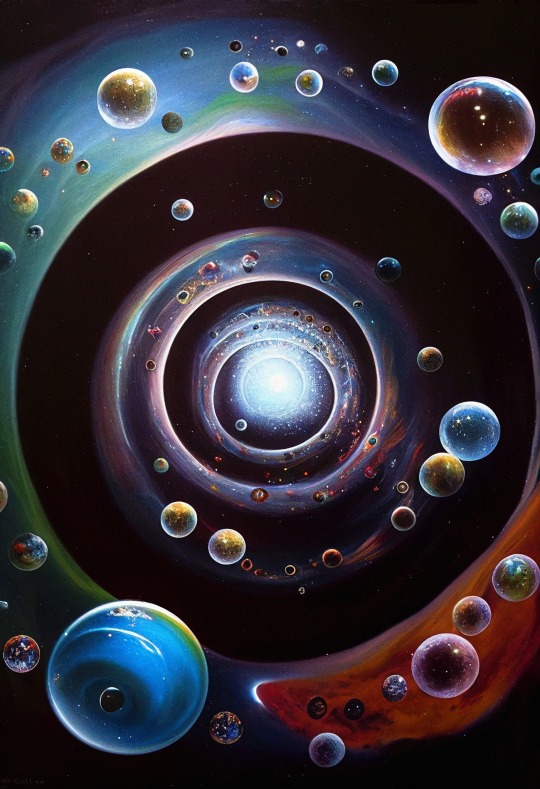
“The world rests as the lotus in the palm of my hand, the cosmos revolves around my finger like a discus. I blow the music of life through my conch and wield my mace to protect all creatures.” – Krishna Upanishad
The Multiverse as Vishnu's Dream
Talon Abraxas
While Brahma creates the Universe, Vishnu is the source of all Creation. And he also sustains and protects the Universe making his role a lot more complex than that of Brahma’s.
Vishnu is the All-Pervading One, derived from “vis’ in Sanskrit which means both ‘to spread’ and ‘to be present everywhere’.
Even when there was Nothing, there was Vishnu, present as a nameless, formless, dormant energy. In this un-manifested (nirguna) state, even Vishnu was not aware of his own being. He just was. But just because he was not perceived, does not mean he did not exist.
In this Nothingness, when the first ripple of awareness stirred , spontaneously and of its own will, the formless energy became Vishnu, the Supreme Being, Parabrahman.
As Parabrahma, Vishnu lies in a dream like state on the serpent Adisesha Ananta who is Time, without beginning or end. Ananta floats for all eternity on the waters of the Ksheer Sagar ( the ocean of Cosmic Consciousness).
When Brahma begins the process of Creation, it is Vishnu who expands into everything and becomes part of everything. Now he is Brahman, the Cosmic Consciousness.
As if he is seeing a dream, Vishnu watches Brahma create the Universe. By the act of watching his dream, Vishnu sustains the Universe. When Vishnu wakes from his dream one cycle of Creation ends.
Vishnu who dreams up the Universe must also now protect it. To maintain the order of Creation, Vishnu becomes The Protector. He takes the form of Ishwara or God.
This form of Vishnu looks very different from the one reclining on Ananta. He is standing,radiant as the sun and has four arms. In his hands he holds the Conch, The Discus, The Lotus and The Mace.
From the Nirguna Brahman( formless energy) Vishnu thus becomes Saguna Brahman, a God with forms and attributes. Vishnu is now the Supreme Lord, Parameshwar.
At times, when world descends into total chaos, Lord Vishnu comes to its rescue in the form of an Avatar, or incarnation.
The ten incarnations of Vishnu in the physical world are:
1.Matsya (fish)
2.Kurma (turtle)
3.Varaha (boar)
4.Narasimha (man-lion)
5.Vamana (dwarf)
6.Parashurama (warrior-priest)
7.Rama ( man who was like God)
8.Krishna (God who was born as man)
9.Buddha (the enlightened one)
10.Kalki (horseman, who has not yet appeared)
References to Vishnu are found even in the Rig Veda, the oldest of the scared texts.
25 notes
·
View notes
Text
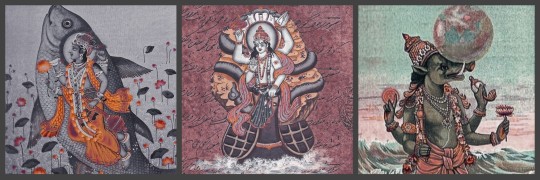
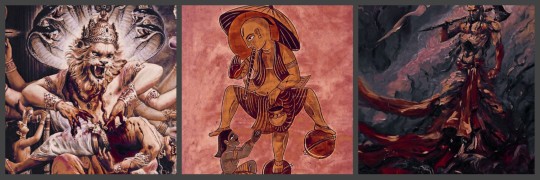
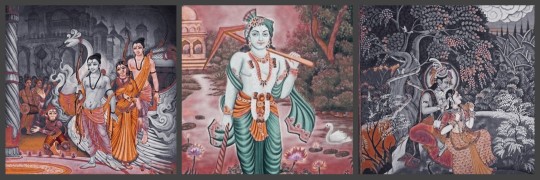

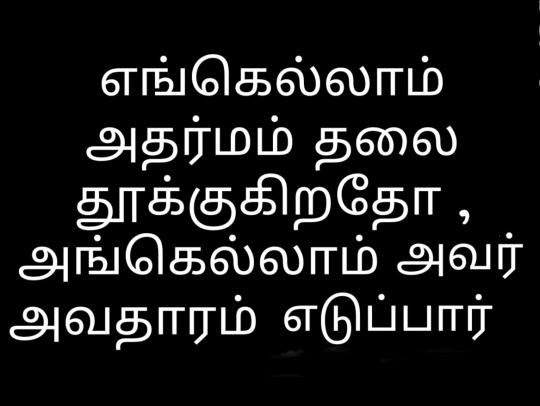

✨The 10 avatars of Lord Vishnu✨ (Dasavatara)
From left to right:
First row: 1. Matsya avatar, 2.Kurma avatar, 3. Varaha avatar
Second row: 4.Narasimha avatar, 5.Vamana avatar 6.Parashurama avatar
Third row: 7.Lord Rama avatar, 8.Balarama avatar, 9.Lord Krishna avatar
Fourth row: 10.Kalki avatar(the quote) which has not appeared yet
Whenever evil prevails over good, Lord Vishnu will incarnate. All avatars have appered except one the Kalki avatar which is said to appear in the kali yuga.
30 days moodboard challenge with
@smr-the-tired-crackhead , @silky-moon , @balladofableedingpoet2112 ,@rainbowsnowflake , @yourbelovedannoyance , @little-star-aesthetic , @nightshade3465 ,@ya-boi-leto @beautiful-tragic , @lemonphrogg , @myfavoriteinvestment ,@chandanbala , @samalaingik , @n1kkiiii ,@rasikata
Day 3: your favorite myth or epic
(Click for better quality)
Some people who might like this one:@suvarnarekha @the-stars-love-us @nacho08 @seekerbrave @psycho-mocha @kajukatliontop @wowyoufeelorphic @jugn00 @metalvenomludens7 @cipher-dorito @charmolypi-reverie @bookishmuggleborn @hecalledmebeloved @tonicaballos @curious-fruitcake @shirothestrangewolf @justalonelywriter @chaoticaindica @book-dragon-not-worm @adoginthemanger @crazy-beautiful @thebengalurubisexual @elentiyathemoonelf @wolfstarrysky
31 notes
·
View notes
Text
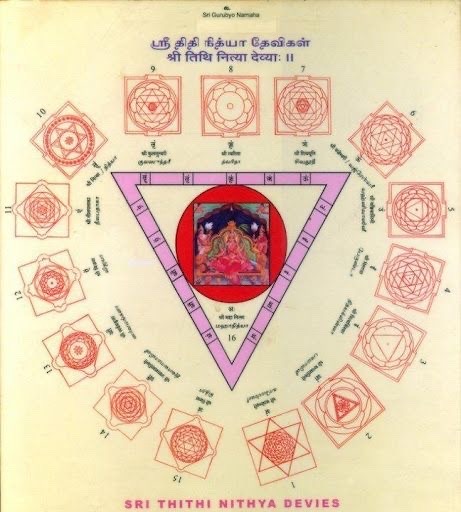
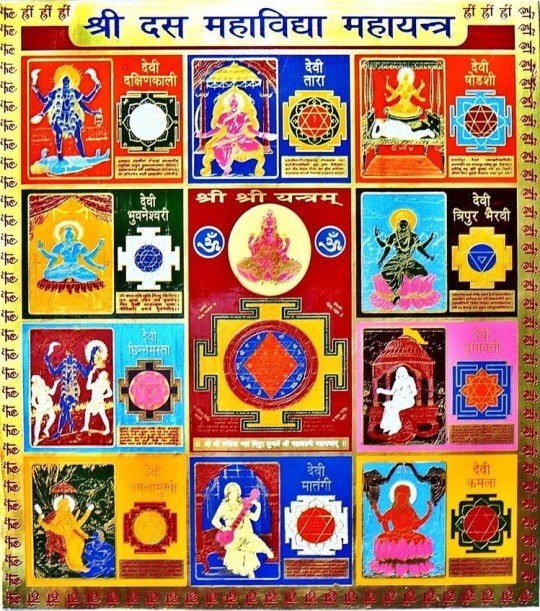
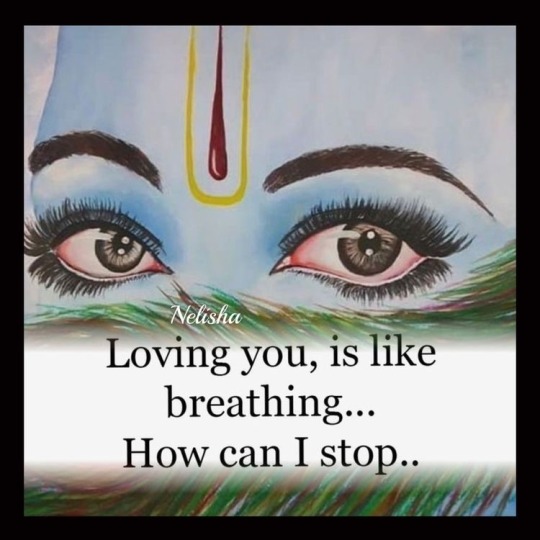
Direction - Worship
Dress
for Puja
Mala
Time
Day
Vidya
Kali
Maharatri
face South
Black
Kali-Hakik
(Black Agate)
Rudraksha
night time
Sunday
Pushya Nakshatra
Adi
Vidya
Tara
Krodharatri
face Her East-West
Rose
Crystal
day time
Wednesday
Pushya Nakshatra
Siddha
Vidya
Shodashi
Divyaratri
face North
White
Silver
Gold
White Agate
Pearls
any time
Friday
Shri
Vidya
Bhuvaneshvari
Siddharatri
any Dik
Yellow
Gold
Yellow Topas
any time
Monday
Friday
Siddha
Vidya
Bhairavi
Kalaratri
Yantra on red cloth
toghether with Bhairav
Red
Red
Vijayamala
Brahman-
muhurta
Sunday
Siddha
Vidya
Chinnamasta
Viraratri
no idol
Yantra on yellow cloth and Akshat Meru (rice)
Yellow
Red
Red
day time
Tuesday
Krishnapaksha
Panchama
Vidya
Dhumavati
Darunaratri
no idol
Copper Yantra
in water
Digambara
(naked)
Black Agate
midnigth
Krishnapaksha
Gurumala
Vidya
Bagalamukhi
Viraratri
along with
Shiva Lingam
Yellow
Turmeric
midnigth
Tuesday
Siddha
Vidya
Matangi
Moharatri
-
Saffron
Siddhamala
(1 to 14 mukhi)
nigth after
10 pm
Thursday
Vidya
Kamala
Maharatri
only on
Shri Yantra
-
Lotus seed
after sunrise
Wednesday
Vidya
Consort
Planet
Chakra
Ten Avatars
Offerings
Kali
Time
Mahakaal
Saturn
Anahata
Krishna
Grains
Tara
Sound
Akshobhya
Jupiter
Swadhishthana
Manipura
Matsya
Egg
Shodashi
Light
Panchavaktra Shiva
Mercury
Sahasrara
Jamadagni
Parashurama
Rice and
Ghee
Bhuvaneshvari
Space
Tryambaka Shiva
Moon
All
Anahata
Vamana
Rice and
Ghee
Bhairavi
Power
Kaal Bhairav
Lagna
Muladhara
Balabhadra
Rice and
Ghee
Chinnamasta
Mind
Kabandha
Rahu
Ajna
Narasimha
Sweet rice
Dhumavati
Void
-
Ketu
-
Varaha
Sweet
Bagalamukhi
Immobility
Ekavaktra Shiva
or Maharudra
Mars
Ajna
Anahata
Kurma
Yogurt
Matangi
Knowledge
Matanga
Sun
Vishuddha
Rama
Fruit
Kamala
Beauty
Sadashiva Vishnu
Venus
Anahata
#kali bhakti#mahavidya#Lolita#nityananda#kalika#bhairavi#bhakti#kali#shakti#shaktism#shambhavi#matakali#kalidevi
12 notes
·
View notes
Text
Name every hindu god
Akasha Achyuta Adimurti Aditi Adityas Agni Ajjayya Amman Anala Anila Annamma Annapurna Anumati Anuradha Ap Apam Napat Aranyani Aravan Ardhanari Ardra Arjuna Aruna Arundhati Aryaman Ashapura Asura Asvayujau Aswiniis Ayya Vaikundar Ayyappan Ayyanar Aryadurga Badrakali Bagalamukhi Bahuchara Mata Balaji Balambika Balarama Banashankari Beeralingeswara Bhadra Bhadrakali Bhaga Bhairava Bhairavi Bharani Bharati Bhavani Bhishma Bhumidevi Bhumiya Bhutamata Bhuvaneshvari Brahma Brahman Brahmani Brihaspati Buddha Buddhi Budhi Pallien Chandi Chandra Chathan Chhinnamasta Chitragupta Chamunda Choudeshwari Dashka Dakshayani Danu Dattatreya Deva Devi Devnarayan Dhanvantari Dhara Dharma Dharma Shasta Dhatri Dhrishtadyumna Dhumavati Diti Draupadi Durga Devi Dyaus Pita Ganapati Ganga Gangothri Garuda Gayatri Gomatha Ghanshyam Guardians of the directions Guru Nanak Gusainji Hanuman Hari Hari Krishna Hari Hara Hrishikesh Huligamma Harbadevi Hingladevi Hombaleshwari Hattilakkamma Indra Indrani Jagaddhatri Jagannath Jalaram Jatayu Jhulelal Jumadi Jyotiba Kali Yuga Kalki Kama Kamadeva Kamalatmika Kamakhya Kamakshi Kanaka Durga Kannaki Amman Kanyakumari Karna Karthikeya Karuppa Swami Kashyapa Kathyayini Katteholeyamma Ketu Khandoba Khatushyamji Khodiyar Kinner Kailash Kirata Moorti Krishna Kubera Kumbhakarna Kunchumamba Kurma Kushmanda Lakshmi Lakshman Lalitha Linga Madurai Veeran Mahakali Mahalasa Mahalaxmi Mahesh Mahavidya Mahavishnu Mahishasura Mardini Mailaralingeshwara Mallanna Manda Mariamman Markandeya Matrikas Manasa Mangala Maruts Matangi Manikanta Matsya Maya calender Meenakshi Mhasoba Mitra Mohini Mookambika Muthyalamma Muttinamma Murugan Muniandi Muthappan Mukyaprana Mulkattamma Muneeswaran Naga Devata Naga siren Naga Yakshi Naina Devi Nandi Nandni Narada Narasimha Narayana Narmada Devi Nataraja Navagrahas Neela Nirrith Nirrta Nookambika Pandavas Parashurama Parasiva Parjanya Parvati Pashupati Perumal Prajapati Prithvi Pushan Purusha Radha Rahu Ram Ramdev Pir Ramnathi Ranganatha Rati Ratri Ravastar Ravi Rbhus Renuka Revanta Rohini Nakshatram Rudra Salumaradamma Samaleswari Santoshi Mata Saranyu Saraswati Sati Savitar Sesha Naga Shani Shakti Shakti Peethas Shantadurga Shitala Shiva Shri Khand Shubhanga Shyam baba Shyamala Sita Skanda Soma Srimanjunatha Subrahmanya Surya Svaha Swaminarayan Tara Tejaji Trimurti Tirupati Thimmappa Tripura Sundari Tvashtri Ugratara Uma Urvashi Ushas Vamana Varaha Varahi Varuna Vasu Vasudeva Vayu Veerabhadra Veer Mhaskoba Venkateshwara Vishnu Vishvaksena Vithoba Vishwakarma Vivasvat Valli Vyasa Vishnumaya Yaksha Yakshini Yama Yamuna Yami Yellamma Yudhishthira Yamini
35 notes
·
View notes